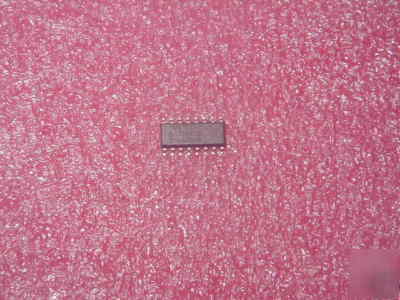Wisconsin Parts Database Instructions and Discussion Team/Group > MICHIGAN
> Motors and tools
> Remove
> Used
> Qty 10 * 74HC191 74HC191D presettable synchronous smd
Qty 10 * 74HC191 74HC191D presettable synchronous smd
Synchronous reversible counting
Count enable control for synchronous expansion
Single up/down control input
The 74HC/HCT191 are high-speed Si-gate CMOS devices and are pin compatible with low power Schottky TTL (LSTTL). They are specified in compliance with JEDECstandard no. 7A. The 74HC/HCT191 are asynchronously presettable 4-bit binary up/down counters. They contain four master/slave flip-flops with internal gating and steering logic to provide asynchronous preset and synchronous count-up and count-down operation. Asynchronous parallel load capability permits the counter to be preset to any desired number. Information present on the parallel data inputs (D0 to D3) is loaded into the counter and appears on the outputs when the parallel load (PL) input is LOW. As indicated in the function table, this operation overrides the counting function. Counting is inhibited by a HIGH level on the count enable (CE) input. When CE is LOW internal state changes are initiated synchronously by the LOW-to-HIGH transition of the clock input. The up/down (U/D) input signal determines the direction of counting as indicated in the function table. The CE input may go LOW when the clock is in either state, however, the LOW-to-HIGH CE transition must occur only when the clock is HIGH. Also, the U/D input should be changed only when either CE or CP is HIGH. Overflow/underflow indications are provided by two types of outputs, the terminal count (TC) and ripple clock (RC). The TC output is normally LOW and goes HIGH when a circuit reaches zero in the count-down mode or reaches 15 in the count-up-mode.
The TC output will remain HIGH until a state change occurs, either by counting or presetting, or until U/D is changed. Do not use the TC output as a clock signal because it is subject to decoding spikes. The TC signal is used internally to enable the RC output. When TC is HIGH and CE is LOW, the RC output follows the clock pulse (CP). This feature simplifies the design of multistage counters, each RC output is used as the clock input to the next higher stage. It is only necessary to inhibit the first stage to prevent counting in all stages, since a HIGH on CE inhibits the RC output pulse as indicated in the function table. The timing skew between state changes in the first and last stages is represented by the cumulative delay of the clock as it ripples through the preceding stages. This can be a disadvantage of this configuration in some applications. The RC outputs propagate the carry/borrow signals in ripple fashion and all clock inputs are driven in parallel. In this configuration the duration of the clock LOW state must be long enough to allow the negative-going edge of the carry/borrow signal to ripple through to the last stage before the clock goes HIGH. Since the RC output of any package goes HIGH shortly after its CP input goes HIGH there is no such restriction on the HIGH-state duration of the clock. Combining the TC signals from all the preceding stages forms the CE input for a given stage. An enable must be included in each carry gate in order to inhibit counting.

